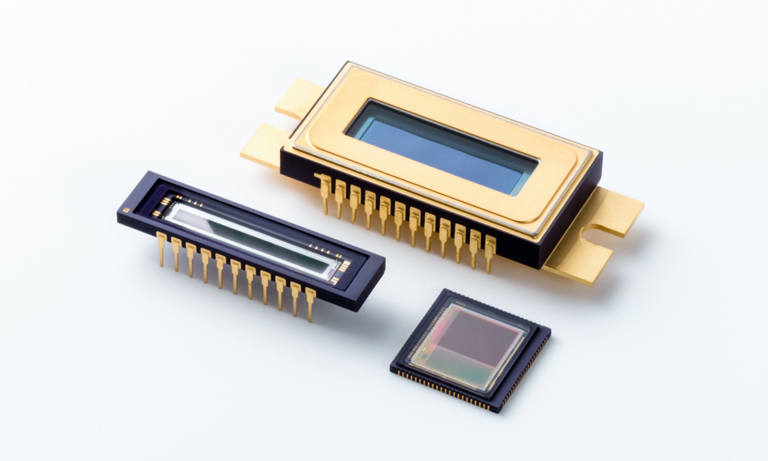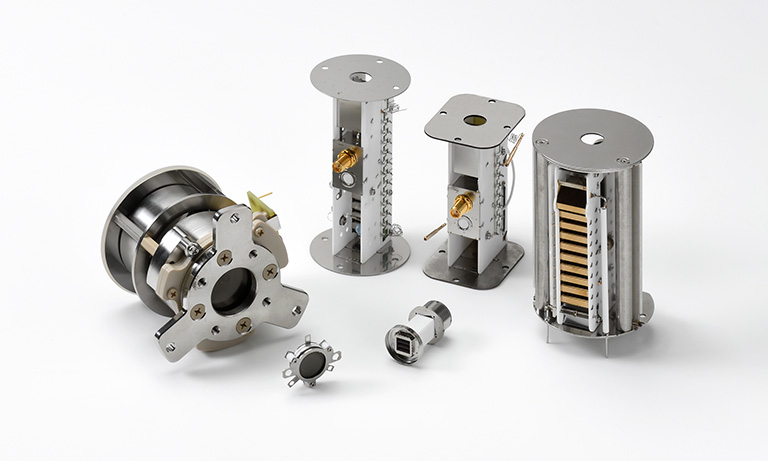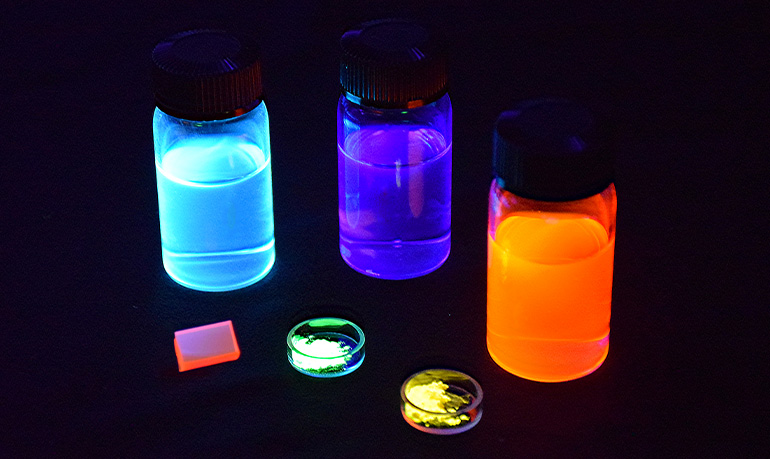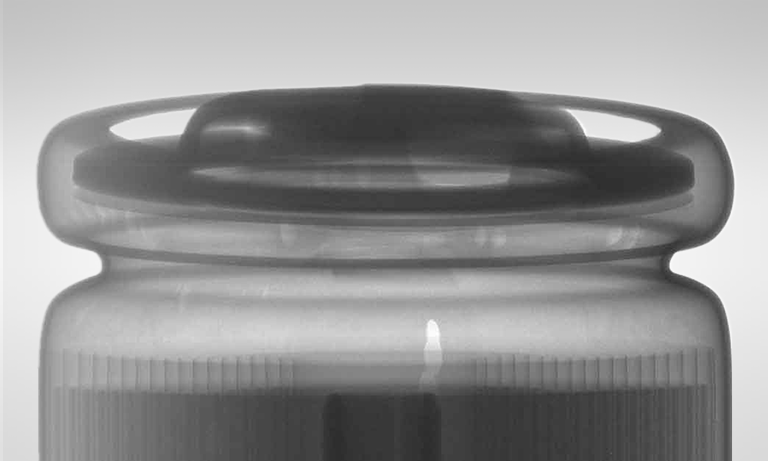United Kingdom (EN)
Select your region or country.


FAQs (CCD) | CCD / CMOS / NMOS image sensors
- What are the main differences between MOS image sensor and CCD image sensor usage?
- What components are needed for using CCD image sensors with a PC?
- To what extent do CCD spectral response characteristics listed in the datasheets vary among individual products?
- In what sequence should power to a CCD be turned on?
- How does overlapping of CCD two-phase clock pulses (P1, P2) affect operation?
- Can I use any voltage if it is within the voltage range of the operating conditions listed in the CCD datasheet?
- Are CCDs sensitive to X-rays?
- CCD datasheets do not list the sensitivity in terms of voltage output (unit: V). How can it be calculated?
- Is a shutter required when capturing images with a CCD?
- Flaws not described on the inspection sheet can be seen in the detected image. Why is that?
- Will problems occur from using a CCD in vacuum?
- Can a CCD be coupled to an FOP?
- To what level should temperature and humidity be maintained during handling of a CCD?
- What measures are required to avoid ESD (electrostatic discharge damage) during handling of a CCD?
- Where should a CCD be stored?
- Can incident light damage the CCD?
- CCDs still generate an output even if the charge integration time is zero. Why is that?
- What is the reason for the large tolerance on CCD packages?
- Multichannel detector heads (camera heads) are not available for some CCD types. Any suggestions on how to use those CCDs?
- Can CCDs with custom specifications such as low dark current or minimum blemishes be chosen for purchase?
- Can you provide CCD image sensors with no flaws or blemishes on the photosensitive surface?
- Can I purchase flawed CCDs at a low price?
- I need data other than those shown in the inspection sheet. Can you supply such data with the product when shipping?
What are the main differences between MOS image sensor and CCD image sensor usage?
MOS image sensors can generally handle a higher electrical charge compared to CCD image sensors, and are used under high light level conditions. CCDs feature low noise and are more suited for detecting low level light. MOS image sensors are also capable of operating on a 5 V supply which makes them easy to handle.
What components are needed for using CCD image sensors with a PC?
Prepare the following components.
1. Prepare the following components.Multichannel detector head or driver circuit (These products for some CCDs might not be available from us. See the image sensor datasheets or selection guide for detailed information.)
2. Multichannel detector head controller C7557-01 (when using a multichannel detector head): Allows easy data acquisition via USB connection to a PC
3. External power supply, A/D converter (Whether these are required depends on the multichannel detector head and driver circuit. See the datasheets.)
4. Frame grabber board (when using a multichannel detector head with a Camera Link interface)
To what extent do CCD spectral response characteristics listed in the datasheets vary among individual products?
Photosensitivity listed in the datasheets are typical values for product specifications and are not guaranteed values. Front-illuminated CCDs for example have somewhat large variations in spectral response characteristics from product to product because they have a structure where CCD gate electrodes are formed on a surface that receives incident light. Near the visible region, back-thinned CCDs have fewer variations in sensitivity compared to the front-illuminated type. In the ultraviolet region however, they exhibit large variations.
If spectral response characteristics for individual products are needed, then consult our sales office nearest you. Please note that spectral response characteristics depend on temperature. See our technical guide for information on the temperature dependence of spectral response characteristics.
In what sequence should power to a CCD be turned on?
We recommend first turning on the DC power to the CCD and then applying the power to the clock system. Turning on power in the reverse sequence or at the same time is not likely to harm the CCD.
How does overlapping of CCD two-phase clock pulses (P1, P2) affect operation?
It is recommended that the clock pulses overlap each other at 50%±10% of their amplitudes. Operation deviating from this condition may affect the saturation charge and charge transfer efficiency, so take this into account if high detection accuracy is required.
Can I use any voltage if it is within the voltage range of the operating conditions listed in the CCD datasheet?
CCD characteristics vary with operating conditions. Operating conditions specified in the datasheet show the adjustment range. They must be adjusted within the specified range. We recommend using the CCD under typical operating conditions. Electrical and optical characteristics listed in the datasheet are the values when used under typical operating conditions.
Are CCDs sensitive to X-rays?
When X-rays are directly incident on a CCD, the front-illuminated type is sensitive to X-rays from 0.5 keV to 10 keV, and the back-thinned type is sensitive from 0.1 keV to 10 keV. Front-illuminated CCDs coupled to an FOS (FOP coated with scintillator) or phosphor sheet are sensitive to X-rays of several ten keV or higher. See our technical information for details. If detecting X-rays at other energy levels, consult our sales office nearest you.
CCD datasheets do not list the sensitivity in terms of voltage output (unit: V). How can it be calculated?
Datasheets contain a graph showing spectral response characteristics [vertical axis: quantum efficiency (QE)] and CCD node sensitivity (Sv). The voltage output at particular wavelengths can be calculated from the quantum efficiency and CCD node sensitivity. This calculation formula is as follows:
V = Number of incident photons × QE × Sv
Is a shutter required when capturing images with a CCD?
When capturing two-dimensional images with an FFT-CCD, its operating principle requires a shutter or similar mechanism to block light so that no light strikes the CCD during charge transfer. (This is to prevent light striking the CCD during charge
transfer from being read out as a signal because the photosensitive area of an FFT-CCD also serves as a charge transfer register.) The signal produced by light incident on the CCD during charge transfer appears like vertical stripes in the acquired image. (This phenomenon is called smear.) If the charge integration time is extremely long compared to the readout time, then there is relatively little shading effect, so the desired image can be acquired even without a shutter.
When operating an FFT-CCD in binning mode, the light incident on the CCD during charge transfer is added to the signal by binning and is read out as one-dimensional data, so there is no problem if used without a shutter.
Flaws not described on the inspection sheet can be seen in the detected image. Why is that?
The inspection sheet conditions are shown on the datasheet. Compare the device using conditions close to those inspection conditions.
Abnormal phenomena that did not occur at the time of shipping inspection might occur due to damage (electrostatic discharge damage or deterioration caused by surge) during handling by the customer or due to unavoidable problems (caused by effects from cosmic rays, etc.) during shipping, so please consult our sales office.
Will problems occur from using a CCD in vacuum?
There is no problem at all when using a front-illuminated CCD with no window under a vacuum of several pascals. However, at vacuum levels higher than approximately 10-2 pascals, the system may sometimes become contaminated from resin and so on, so please consult us. Back-thinned CCDs have also been used in vacuum, so please consult us if using them in vacuum.
Can a CCD be coupled to an FOP?
Nearly all front-illuminated CCDs can be coupled to an FOP.
However, back-thinned CCDs cannot be coupled to an FOP. Please consult our sales office for more details.
To what level should temperature and humidity be maintained during handling of a CCD?
To find the temperature range, see the operating temperatures and storage temperatures listed in the datasheet. The temperature and humidity must meet the conditions that will not cause moisture condensation on the sensor. Using at a humidity from 45% to 55% is recommended. Use in this recommended humidity range is also necessary as an ESD countermeasure.
What measures are required to avoid ESD (electrostatic discharge damage) during handling of a CCD?
Static electricity can destroy a CCD, so care is required during handling. We recommend using a workbench fitted with ESD
countermeasures, wrist straps, conductive mats, etc. Use of an ionizer is also recommended to remove static electricity that may be generated during handling. See the "Precautions" of CCD image sensors for detailed information.
Where should a CCD be stored?
See the "Precautions" of CCD image sensors for the instructions on how to store a CCD. After unpacking, we recommend storing in a low humidity desiccator.
Can incident light damage the CCD?
Visible light cannot damage the CCD. However, ultraviolet light, X-rays and other high-energy radiation can cause damage.
See our technical information for details.
CCDs still generate an output even if the charge integration time is zero. Why is that?
CCDs generate dark current even during readout operation. So even if the charge integration time is zero, there is still an output including dark current.
What is the reason for the large tolerance on CCD packages?
The packages mainly use ceramic materials, so manufacturing the package within a small tolerance is difficult. In view of quality control, the package tolerance is set to a large figure. Special processing techniques may make the package tolerance smaller, so consult us if needed.
Multichannel detector heads (camera heads) are not available for some CCD types. Any suggestions on how to use those CCDs?
Multichannel detector heads are not available for some CCD types, but simple evaluation circuit boards may be available for them. Contact our sales office for more information.
Can CCDs with custom specifications such as low dark current or minimum blemishes be chosen for purchase?
Custom specifications may be available at extra cost for some CCDs. Please contact our sales office if needed.
Can you provide CCD image sensors with no flaws or blemishes on the photosensitive surface?
Types with no flaw or blemish may be available at extra cost for some CCDs. Please contact our sales office if needed.
Can I purchase flawed CCDs at a low price?
Some CCD types with flaws or blemishes may be available. Please contact our sales office if necessary.
I need data other than those shown in the inspection sheet. Can you supply such data with the product when shipping?
If that data can be prepared, then we will provide it for a fee.
- Confirmation
-
It looks like you're in the . If this is not your location, please select the correct region or country below.
You're headed to Hamamatsu Photonics website for GB (English). If you want to view an other country's site, the optimized information will be provided by selecting options below.
In order to use this website comfortably, we use cookies. For cookie details please see our cookie policy.
- Cookie Policy
-
This website or its third-party tools use cookies, which are necessary to its functioning and required to achieve the purposes illustrated in this cookie policy. By closing the cookie warning banner, scrolling the page, clicking a link or continuing to browse otherwise, you agree to the use of cookies.
Hamamatsu uses cookies in order to enhance your experience on our website and ensure that our website functions.
You can visit this page at any time to learn more about cookies, get the most up to date information on how we use cookies and manage your cookie settings. We will not use cookies for any purpose other than the ones stated, but please note that we reserve the right to update our cookies.
1. What are cookies?
For modern websites to work according to visitor’s expectations, they need to collect certain basic information about visitors. To do this, a site will create small text files which are placed on visitor’s devices (computer or mobile) - these files are known as cookies when you access a website. Cookies are used in order to make websites function and work efficiently. Cookies are uniquely assigned to each visitor and can only be read by a web server in the domain that issued the cookie to the visitor. Cookies cannot be used to run programs or deliver viruses to a visitor’s device.
Cookies do various jobs which make the visitor’s experience of the internet much smoother and more interactive. For instance, cookies are used to remember the visitor’s preferences on sites they visit often, to remember language preference and to help navigate between pages more efficiently. Much, though not all, of the data collected is anonymous, though some of it is designed to detect browsing patterns and approximate geographical location to improve the visitor experience.
Certain type of cookies may require the data subject’s consent before storing them on the computer.
2. What are the different types of cookies?
This website uses two types of cookies:
- First party cookies. For our website, the first party cookies are controlled and maintained by Hamamatsu. No other parties have access to these cookies.
- Third party cookies. These cookies are implemented by organizations outside Hamamatsu. We do not have access to the data in these cookies, but we use these cookies to improve the overall website experience.
3. How do we use cookies?
This website uses cookies for following purposes:
- Certain cookies are necessary for our website to function. These are strictly necessary cookies and are required to enable website access, support navigation or provide relevant content. These cookies direct you to the correct region or country, and support security and ecommerce. Strictly necessary cookies also enforce your privacy preferences. Without these strictly necessary cookies, much of our website will not function.
- Analytics cookies are used to track website usage. This data enables us to improve our website usability, performance and website administration. In our analytics cookies, we do not store any personal identifying information.
- Functionality cookies. These are used to recognize you when you return to our website. This enables us to personalize our content for you, greet you by name and remember your preferences (for example, your choice of language or region).
- These cookies record your visit to our website, the pages you have visited and the links you have followed. We will use this information to make our website and the advertising displayed on it more relevant to your interests. We may also share this information with third parties for this purpose.
Cookies help us help you. Through the use of cookies, we learn what is important to our visitors and we develop and enhance website content and functionality to support your experience. Much of our website can be accessed if cookies are disabled, however certain website functions may not work. And, we believe your current and future visits will be enhanced if cookies are enabled.
4. Which cookies do we use?
There are two ways to manage cookie preferences.
- You can set your cookie preferences on your device or in your browser.
- You can set your cookie preferences at the website level.
If you don’t want to receive cookies, you can modify your browser so that it notifies you when cookies are sent to it or you can refuse cookies altogether. You can also delete cookies that have already been set.
If you wish to restrict or block web browser cookies which are set on your device then you can do this through your browser settings; the Help function within your browser should tell you how. Alternatively, you may wish to visit www.aboutcookies.org, which contains comprehensive information on how to do this on a wide variety of desktop browsers.
5. What are Internet tags and how do we use them with cookies?
Occasionally, we may use internet tags (also known as action tags, single-pixel GIFs, clear GIFs, invisible GIFs and 1-by-1 GIFs) at this site and may deploy these tags/cookies through a third-party advertising partner or a web analytical service partner which may be located and store the respective information (including your IP-address) in a foreign country. These tags/cookies are placed on both online advertisements that bring users to this site and on different pages of this site. We use this technology to measure the visitors' responses to our sites and the effectiveness of our advertising campaigns (including how many times a page is opened and which information is consulted) as well as to evaluate your use of this website. The third-party partner or the web analytical service partner may be able to collect data about visitors to our and other sites because of these internet tags/cookies, may compose reports regarding the website’s activity for us and may provide further services which are related to the use of the website and the internet. They may provide such information to other parties if there is a legal requirement that they do so, or if they hire the other parties to process information on their behalf.
If you would like more information about web tags and cookies associated with on-line advertising or to opt-out of third-party collection of this information, please visit the Network Advertising Initiative website http://www.networkadvertising.org.
6. Analytics and Advertisement Cookies
We use third-party cookies (such as Google Analytics) to track visitors on our website, to get reports about how visitors use the website and to inform, optimize and serve ads based on someone's past visits to our website.
You may opt-out of Google Analytics cookies by the websites provided by Google:
https://tools.google.com/dlpage/gaoptout?hl=en
As provided in this Privacy Policy (Article 5), you can learn more about opt-out cookies by the website provided by Network Advertising Initiative:
http://www.networkadvertising.org
We inform you that in such case you will not be able to wholly use all functions of our website.
Close


























































































































